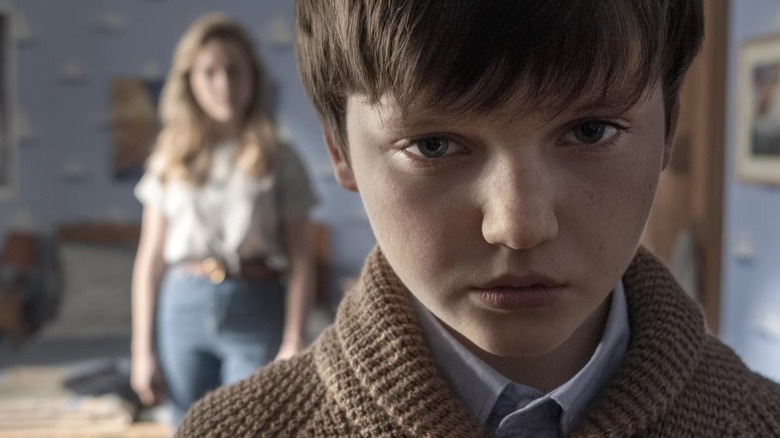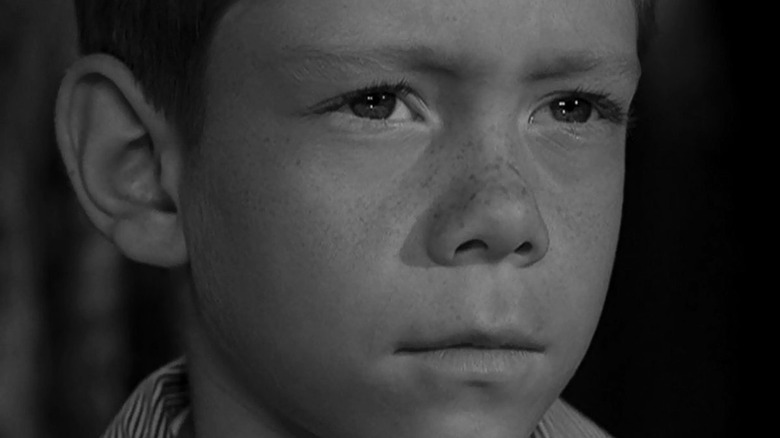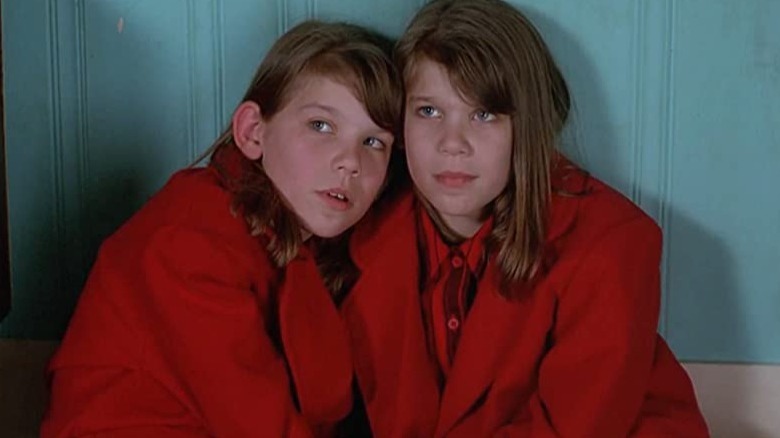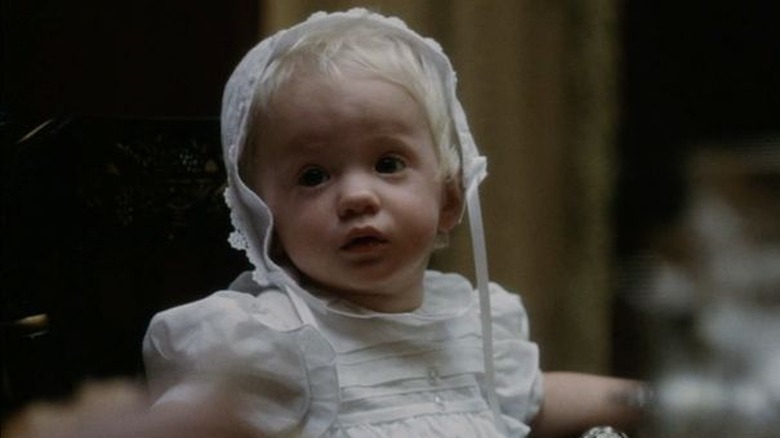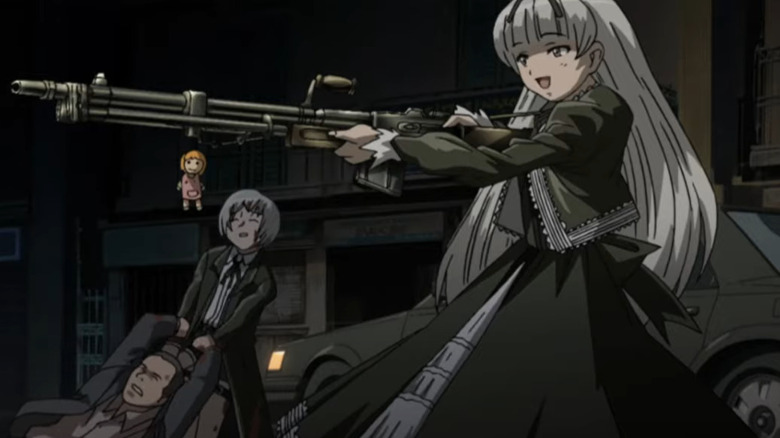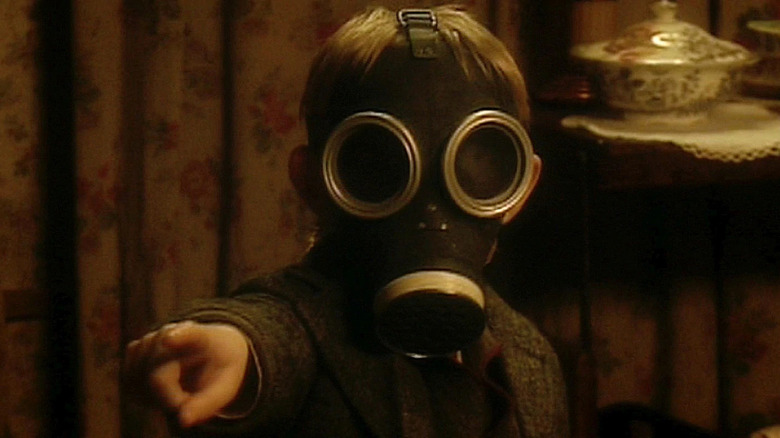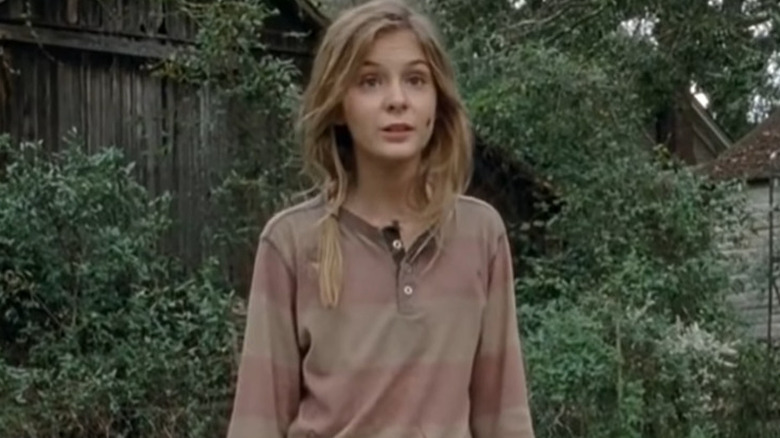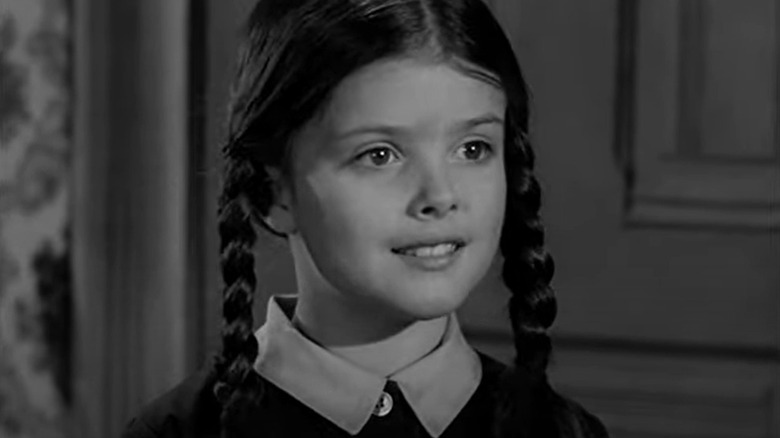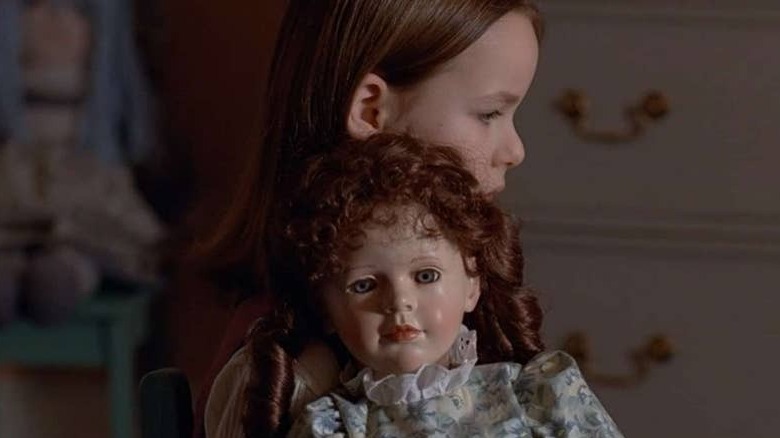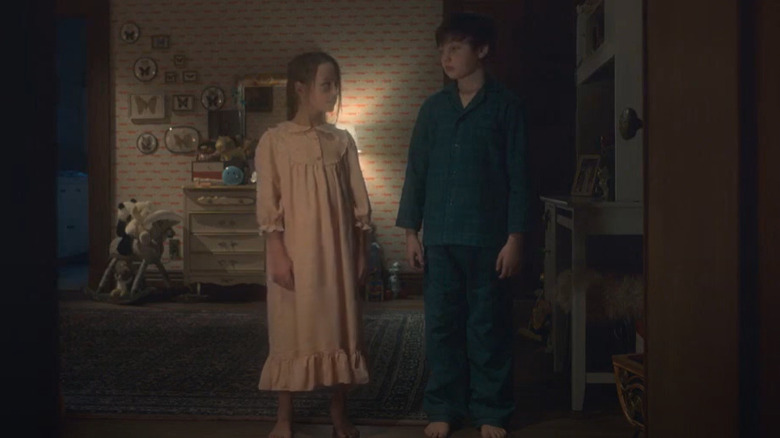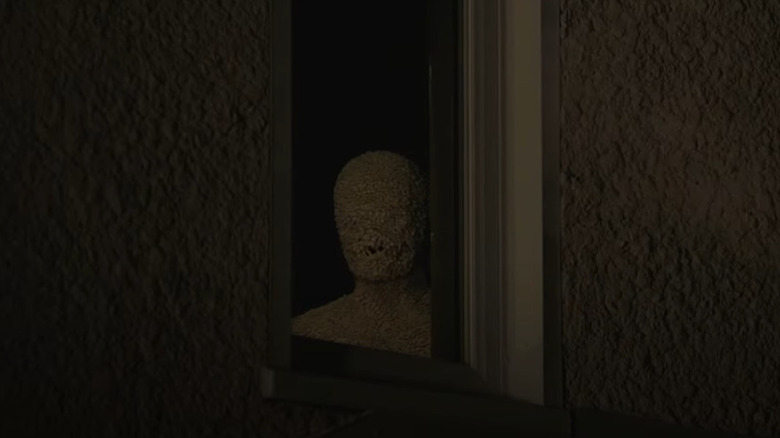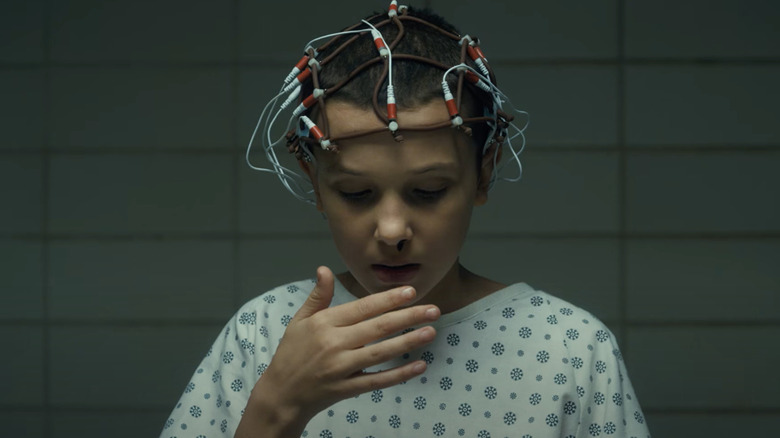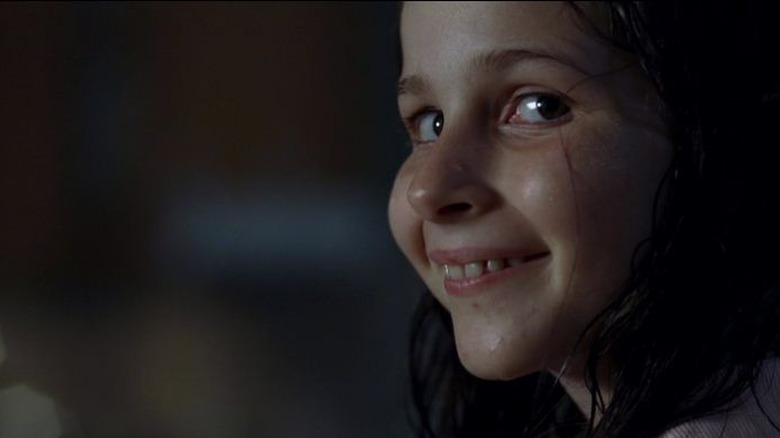The Scariest Children In TV History
Nothing is more chilling than breaking down and deconstructing the things that make us human. The desire to protect a child, for example, is one of our most firmly established convictions — which is why any depiction of a child as the proverbial monster in the dark is so deeply unsettling. With horror as a genre relying on creativity to craft a compelling story, our fear of the unknown and unexplainable is what drives home the terror when children are written to be darker and more dangerous than they seem. While frightening child characters are nothing new, that type of portrayal on television is surprisingly less common than in film and literature. Whether it be the difficulty of finding child actors whose performance can resonate with audiences, or the enduring difficulty of balancing a child actor growing up with the duration of many television series, those that can overcome the challenges have left us with truly memorable performances. With that in mind, here's a look at the scariest children in TV history.
Anthony Fremont, The Twilight Zone
The oldest TV show on our list, "The Twilight Zone" aired weekly installments from 1959 to 1964 that can be said to have helped serve as an inspiration for modern horror television as we know it today. Whether the series was challenging viewers to ask moral questions about society at large or providing downright terrifying images that have worked their way into pop culture, there's no disputing its legendary status. Host and creator Rod Serling was not afraid to push his audience's boundaries with his work, and the episode "It's A Good Life" serves as a perfect example of Serling's creative genius.
This story centers around a young boy named Anthony Fremont, whose godlike telekinetic powers allow him to bring the people of his town to their knees. While his juvenile view of the world prevents him from seeing the impact of his actions, he doesn't hesitate to retaliate when aggravated. Those who dare to challenge young Anthony's will find themselves wished away to a cornfield, presumably never to be seen again. As the episode progresses, the people of the town grow increasingly desperate, even urging for the boy to be killed so they can escape his control. Ultimately, however, Anthony's grasp on the town proves too strong, as he quells any resistance by banishing his would-be killers to the cornfield like so many before them.
Cindy and Teena, The X-Files
Running from 1993 to 2002, "The X-Files" managed to captivate fans of both sci-fi and horror alike with its mysterious setting. Following FBI agents Fox Mulder and Dana Scully as they investigate criminal activity that, more often than not, is connected to the paranormal, the series had no shortage of disturbing stories to tell. As the pair investigate the eerily similar murder of two young girls' fathers, they begin to unravel a mystery of twisted government experimentation gone wrong. It is revealed to Mulder that the girls are just two of many more people, all the wayward result of the government's attempt to create a new breed of super-soldier, whose heightened abilities are only matched by their murderous intent. While Mulder and Scully still believe the girls to be innocent of any wrongdoing, it's only after one of the twins attempts to poison Scully's drinks that their psychosis is finally fully understood. The twins' manipulative behavior and chilling lack of remorse for the death and destruction they cause to all they encounter solidifies this episode as one all-time most disturbing installments of "The X-Files."
Thaddeus Montgomery, American Horror Story
Fans love the ongoing series "American Horror Story" for its unique settings, slow burn storylines, and above all its unique approach to the horror genre. The show certainly doesn't pull any punches when it comes to disturbing themes either, with violent and sexual themes that may leave even the most seasoned viewers uncomfortable. Thaddeus Montgomery's backstory is nothing short of tragic — he was abducted and subsequently murdered as a retaliation against his father Charles. When Thaddeus's dismembered corpse is returned to his father, he feels the only thing left to do is to try to reanimate his son's body. While he does succeed, what rises from the dead is no longer his son, but instead the "Infantata," an inhuman monster with a hunger for blood. After Charles' wife is bitten by the undead child, she breaks down and kills herself and her husband, leaving whatever currently inhabits her late son's body lying in wait for its next victim.
Hänsel & Gretel, Black Lagoon
The only animated entry on our list, "Black Lagoon" follows a former office worker swept into a world of violence and crime. While the series is better known for its tongue in cheek storylines about the criminal underworld and over the top and often brutal action sequences than it is for anything that's outright scary, one arc in particular switches the show's tone to borderline horror by focusing on a pair of Romanian twins donned in gothic attire. Hänsel and Gretel have an insatiable bloodlust which they owe to their traumatic upbringing. Forced to kill to survive from a young age, the twins believe the whirlwind of death that surrounds them can prolong their own lives. What ensues is some of the most satisfying action sequences throughout "Black Lagoon," interspersed with nonstop gore as the duo mow down anyone who dares get in their way. The twins' nonchalant attitude towards violence, as well as their innocent appearance, allows them to slaughter plenty of the targets they're sent to dispatch, relying on their experience and proficiency with firearms to come out on top of almost every fight they find themselves in.
The Empty Child, Doctor Who
"Doctor Who" is known for its fantastical plotlines, often pitting the time lord and his companions against anything from sentient statues to the iconic Daleks. Though the series is primarily focused on telling stories firmly rooted in science fiction, the writers aren't afraid to cross the line into borderline horror from time to time.
While following an unidentified metal object through the time vortex, the Doctor and his companion Rose arrive in London in the middle of the Blitz. As Rose spots a young boy donning a gas mask who quickly evades her, the plot quickly pivots from the mundane to the downright bizarre. After receiving a phone call from the Tardis itself, to which the only reply is a child calling for his mother, the Doctor probes the people of London on the whereabouts of the object he is pursuing. His arrival at a nearby hospital reveals many patients who, despite traumatic injuries, are still very much alive, albeit unresponsive. Further adding to the mystery is that all have had gas masks seemingly fused to their skin, which is only demonstrated as we horrifically watch the last remaining doctor on staff at the hospital morph into yet another comatose victim. As the story progresses and the mystery is unraveled, the technological plague that has ravaged the victims of the Blitz is only made more chilling by the fact that their symptoms mirror the words of a dying child whose cry for help has spread as a symptom to all those affected.
Lizzie Samuels, The Walking Dead
The long-running series "The Walking Dead" owes its breakout success to an array of well-written characters and gripping storylines, which time and time again prove to defy audience expectations. No character better highlights the unpredictable world the survivors find themselves in than Lizzie Samuels, whose fascination with the morbid and casual attitude towards the walkers constantly threaten her fellow survivors. While Lizzie seems like a normal girl for much of the time she's onscreen, her behavior becomes gradually more unsettling as her time on the show wears on. Her mental state is completely unstable, shown by her mutilation of small animals and out of touch perspective with the world. She fails to understand the true threat the walkers pose, instead referring to them as her friends and becoming visibly upset whenever one is killed. Though Carol and the others try to reason with her, hoping that she can be persuaded, it ultimately proves fruitless as Lizzie's violent behavior reaches a climax. When left alone, Lizzie murders her sister in an effort to prove that when she came back as a walker, it would solidify her theory that they were as friendly as she thought. It soon becomes clear to Carol that Lizzie is beyond helping, and, in one of the most disturbing scenes in the history of "The Walking Dead," she's forced to execute Lizzie for the safety of the other survivors.
Wednesday Addams
Although the series is decidedly tame by modern standards, "The Addams Family" is still a fun satirical take on the traditional family sitcom. Based on the long-running comics characters of the same name, the 1964 television series is centered around the titular family, whose obsession with the macabre and supernatural powers leave them at odds with the other residents of their community. The dark and gloomy setting, drawing inspiration from the most hellish place on Earth, extends even to the youngest member of the family. Wednesday Addams can best be described as a quirky young girl, but several degrees beyond anything you would expect from the average child. Her passion for raising spiders is sure to be at odds with any viewers prone to arachnophobia, and her grotesque paintings probably wouldn't be at home above many families' fireplaces. Despite her eccentric behavior, she is still a sweet girl, serving as a comical addition to the creepy, kooky cast of characters.
Polly and Chinga, The X-Files
While legendary horror writer Stephen King stepping in to write an episode of "The X-Files" had incredible potential, fans remain divided on the execution of the project. And while much of the story feels plodding, the episode, titled "Chinga," shines with its depiction of main character Polly and her titular doll. After a small-town grocery store is the site of a horrific case of mass self-mutilation, with shoppers attempting to gouge their own eyes out en masse, Scully starts to investigate a potential connection between the grisly scene and the one girl and her mother who left unscathed. In classic creepy kid fashion, Polly carries the doll with her everywhere, and as the audience learns, it acts as a vessel to carry out Polly's frustration with the people around her in the most brutal ways imaginable. When Polly doesn't get her way at an ice cream shop in town, her doll awakens, attempting to murder the employee who aggravated her. One by one those who attempt to interfere with them are met with gruesome fates, all self-inflicted. At her breaking point, Polly's mother attempts to burn the house down with herself and her daughter inside. It's only thanks to Scully that the family is saved when she destroys the doll, revealing that it had Polly under its control the entire time.
Flora and Miles Wingrave, The Haunting of Bly Manor
Netflix's "The Haunting Of Bly Manor" is light on the typical jumpscares and predictability that can drag a good horror piece down, instead opting to craft a compelling story that is as somber as it is chilling. When Danielle Clayton arrives at Bly Manor to serve as an au pair for two orphaned children, Flora and Miles Wingrave, it soon becomes clear the children know more than they are letting on about the estate. While their behavior may not immediately suggest the paranormal — Flora strongly urges Danielle to stay away from the Manor's lake, for example, and Miles locks her in the closet one night — it quickly escalates to nightmarish levels. With Miles' behavior becoming unabashedly unlike a 10-year-old boy, and Flora frequently finding herself near the lake, unable to recall how she arrived there, it's revealed the children are under the possession of two former lovers who died on the property.
Though Miles is under the control of an adult, it makes it no less uncomfortable to watch as he attempts to seduce Danielle, only to choke her from behind later that night. As it turns out, though, Miles' most disturbing action occurred just moments prior to Danielle's arrival at Bly Manor — after his secret was uncovered by housekeeper Hannah Grose, he shoved her down a well, killing her in a fit of rage. Thankfully, at the conclusion of the series, the children are spared from any memory of the terrifying ordeal they've lived through.
Tooth Child, Channel Zero
The stories told during "Channel Zero” are loosely based on popular urban legends spread on the internet, better known as "Creepypastas," with each six-episode season exploring a separate story. The show's first season proved immensely popular with audiences and critics alike, and many horror fans might recognize season one's theme as being centered around Candle Cove, a fictional television program with the ability to alter the memories of its viewers. When Mike Painter returns to his hometown, the stage for what's to come is set by his memories of a string of murders that occurred during his childhood at the hands of a still unknown killer, with his brother Eddie among the victims. As the season progresses, it is revealed that Eddie was responsible for the children's deaths, as he methodically carried out the killings until being put to a stop by Mike. Though his physical body was killed, Eddie's spirit persists in the town, taking the form of a nightmarish childlike entity entirely made of human teeth. While the Tooth Child is frightening enough, the creators of the show opted to film many of the shots featuring Eddie's physical form during the daytime, resulting in some truly unnerving scenes.
Eleven, Stranger Things
One of the top-rated television shows in recent memory, "Stranger Things" is truly a nostalgic trip done right, retaining everything we love about classic '80s media while remaining unafraid to add a refreshing twist to the genre. The standout cast only adds to the phenomenal quality of the show, and though most of the actors have now entered adulthood, finding and retaining a full ensemble of capable child actors for the first few seasons was certainly no easy feat. While many of the most frightening aspects of "Stranger Things" are the antagonists of the series, one notable exception is Eleven, whose telekinetic powers serve as the greatest asset to protect her friends while also being the very reason they are in danger. After being used as a guinea pig for government experiments almost from birth, Eleven is left with powers that she finds difficult to fully control at times, especially when under duress. It is revealed that during one of the many experiments she was subjected to, she inadvertently created a link to the terrifying shadow reality known as the Upside Down, an alternate dimension now seeping into our own. While Eleven always means well, her uncanny abilities make her a powerful albeit unsettling ally.
Cicero Indiana Kids, Supernatural
Though "Supernatural" may never have been as popular as some of our other entries, it can thank its dedicated fanbase, as well as the great chemistry between its two lead characters, for its impressive 15-season run. Experienced viewers may draw comparisons between "Supernatural" and "The X-Files," with similar themes and an abundance of unique and memorable scares.
While visiting an old girlfriend under the guise of investigating a mysterious murder in Cicero, Indiana, co-lead character Dean Winchester finds out that what he thought was a son he didn't know he had is actually something even scarier: a changeling kidnapping the town's children. The only thing creepier than the idea of all the children in town being imposters is why they're there at all — specifically, to get close to the children's mothers and slowly feed off them. While the brothers are able to uncover the changeling plot and save the kids before it's too late, the same can't be said for the mother, who is burned to death by Dean and his brother/fellow supernatural hunter Sam with a DIY flamethrower.
